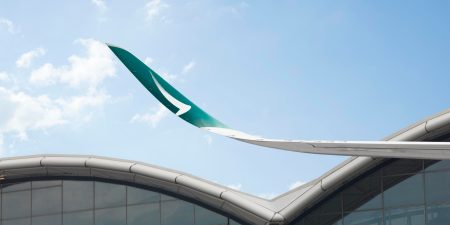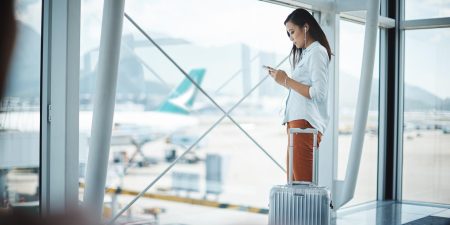Cathay Pacific announces 2013 Annual Results
|
Results |
|
2013 |
2012 (restated) |
Change |
|
Turnover |
HK$ million |
100,484 |
99,376 |
+1.1% |
|
Profit attributable to the owners of Cathay Pacific |
HK$ million |
2,620 |
862 |
+203.9% |
|
Earnings per share |
HK cents |
66.6 |
21.9 |
+204.1% |
|
Dividend per share |
HK$ |
0.22 |
0.08 |
+175.0% |
The Cathay Pacific Group today announced an attributable profit of HK$2,620 million for 2013. This compares to a profit of HK$862 million (restated) in the previous year. Earnings per share were HK66.6 cents compared to earnings per share of HK21.9 cents (restated) in 2012. Turnover for the year increased by 1.1% to HK$100,484 million.
The improvement in the Group’s performance in 2013 was largely due to the strengthening of its passenger business and the positive impact of measures introduced in 2012 to protect the business from the high price of jet fuel. The cargo business continued to be affected by strong competition and weak demand, though there was some seasonal improvement in the last quarter of 2013. The business overall continued to be affected by the sustained high price of jet fuel. The share of profits from non-airline subsidiaries and from associates decreased to HK$781 million from HK$1,126 million (restated).
Passenger revenue in 2013 increased by 2.4% to HK$71,826 million. Capacity decreased by 1.8% due to the continuation of 2012’s reduction in long-haul frequencies and the accelerated retirement of Boeing 747-400 passenger aircraft. However, capacity began to increase towards the end of the year as frequencies were restored and new routes were introduced. The load factor increased by 2.1 percentage points to 82.2%, while yield improved by 1.8% to HK68.5 cents. Passenger demand was strong on long-haul routes in all classes of travel. However, demand on regional routes did not match the increase in capacity on these routes, which left yield under pressure.
The Group’s cargo business has been adversely affected by weak demand since April 2011. There was some recovery in business during the last three months of 2013, though business was still weaker than the same period of 2012. The Group’s cargo revenue in 2013 was HK$23,663 million, a decline of 3.6% compared to the previous year. Yield for Cathay Pacific and Dragonair decreased by 4.1% to HK$2.32. Capacity increased by 1.7% but the load factor fell by 2.4 percentage points to 61.8%. Capacity was adjusted in line with demand throughout 2013 and more cargo was carried in the bellies of passenger aircraft in order to reduce costs. The airline’s new cargo terminal at Hong Kong International Airport became fully operational in October 2013 and will allow us to improve efficiency and to reduce costs in the long term.
The price of jet fuel remains a concern for Cathay Pacific and the industry as a whole. Fuel remains the Group’s most significant cost, accounting for 39.0% of total operating costs in 2013. In April 2013 the airline took advantage of a brief drop in fuel prices to extend its fuel hedging into 2016. The Group’s fuel costs in 2013 (disregarding the effect of fuel hedging) decreased by 4.6% compared to 2012. This was largely a result of the introduction, in 2012, of measures including changing schedules, reducing capacity, withdrawing older, less fuel-efficient aircraft from service and taking delivery of new, more fuel-efficient aircraft.
In 2013 Cathay Pacific continued to upgrade its fleet, taken delivery of 19 new aircraft: five Airbus A330-300 aircraft (including one for Dragonair), nine Boeing 777-300ER aircraft and five Boeing 747-8F freighters. Five Boeing 747-400 passenger aircraft were retired during the period. In March 2013, the airline entered into agreements in relation to the cargo fleet as part of a package of transactions involving The Boeing Company, Cathay Pacific, Air China Cargo and Air China that included the purchase of three Boeing 747-8F freighters (which were delivered in December 2013), cancelled orders for eight Boeing 777-200F freighters, acquired options to purchase five Boeing 777-200F freighters and agreed to sell four Boeing 747-400BCF converted freighters. Also in December 2013, the airline announced an order for 21 new Boeing 777-9X aircraft (for delivery after 2020), three new Boeing 777-300ER aircraft and one new Boeing 747-8F freighter, and to sell six existing Boeing 747-400F freighters. As at 31st December 2013 the Group had a total of 95 aircraft on firm order for delivery by 2024. Cathay Pacific and Dragonair are to take delivery of 16 new aircraft in 2014, one of which was delivered in January 2014.
The Group continued to develop its networks in 2013. It fully restored the long-haul passenger frequencies to Los Angeles, Toronto and New York that were cancelled in 2012. A fifth daily frequency was added to the London route in June and a four-times-weekly service to Male in the Maldives was introduced in October. Cathay Pacific launched a daily service to Newark in the United States in March 2014, will launch a daily service to Doha in late March 2014 and will add more flights to Los Angeles and Chicago from the summer 2014. The airline introduced freighter services to Guadalajara in October 2013 and extended this service to Mexico City in March 2014 and will add a freighter service to Columbus in the United States in late March 2014. Dragonair launched flights to Da Nang, Siem Reap, Wenzhou, Yangon and Zhengzhou in 2013 and will begin a two-times-weekly service to Denpasar, Bali in Indonesia in April 2014.
On the product side, premium economy class was available on 85 long-haul and medium-haul Cathay Pacific aircraft by the end of 2013, while the installation of new regional business class seats will be completed by the third quarter of 2014. Other projects include the introduction of the restyled and upgraded first class cabins on Boeing 777-300ER aircraft and the installation of new business class and economy class seats in Dragonair’s aircraft. The renovated first class lounge at The Wing reopened in February and the airline opened The Bridge, its fifth departure lounge at Hong Kong International Airport, in October 2013.
The share of profits from non-airline subsidiaries and from associates decreased by 30.6% to HK$781 million. This mainly reflects the start up costs of Cathay Pacific’s new cargo terminal, which became fully operational in October 2013, after a phased opening which began in February 2013. The results also continued to be affected by the performance of Air China Cargo, the airline’s cargo joint venture with Air China. The financial performance of the new cargo terminal in 2014 will benefit from the absence of start up costs. Air China Cargo’s financial performance in 2014 will benefit from the steps taken to improve its profitability referred to below.
The Group continued to develop its strategic partnership with Air China. Steps taken to improve the financial performance of Air China Cargo included the purchase of fuel-efficient Boeing 777-200F freighters. A new ground-handling company, Shanghai International Airport Services Co., Limited, began operations in February 2013. This joint venture between Cathay Pacific, Air China, Shanghai Airport Authority and Shanghai International Airport Co. Ltd. provides ground-handling services at Shanghai’s two international airports, Hongqiao and Pudong.
Cathay Pacific Chairman Christopher Pratt said: “The operating environment remained challenging throughout 2013, for the Group and the aviation industry as a whole. It was encouraging to see an improvement in our overall performance, and the strength of the passenger business reflects our continuing investment in network development and providing superior service and world-beating products. The cargo business continues to be problematic. There is still no sign of any sustained improvement in the market and some changes in the business appear now to be structural rather than cyclical. We thus have reduced the size of our freighter fleet and at the same time increased its efficiency.
“We remain confident in Hong Kong’s future as an air cargo centre and believe that our reshaped freighter fleet and our new cargo terminal will allow us to compete successfully in the long term. The business outlook for 2014 looks to be improved when compared to 2013. We will continue to invest to make our business stronger while keeping our financial position strong. As always, we remain committed to strengthening the world class aviation hub in our home, Hong Kong.”










